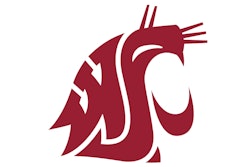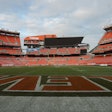Copyright 2018 Worcester Telegram & Gazette, Inc.
All Rights Reserved
Telegram & Gazette (Massachusetts)
WORCESTER — While the city is confident its $70 million investment in an $86 million to $90 million stadium for the Worcester Red Sox will pay for itself over 30 years, two local economists say taxpayers should be concerned.
"I am far less optimistic about this public investment," Robert Baumann, chairman of the Department of Economics and Accounting at the College of the Holy Cross, wrote in an opinion column for the Sunday Telegram. "(Research shows) public money towards stadium construction is rarely, if ever, worth the investment."
The city intends to borrow $100 million over 30 years to pay for the project. The PawSox will kick in up to $34 million and cover cost overruns.
Financial details of the deal were not the at the center of Friday's press conference, with PawSox Chairman Larry Lucchino at one point remarking it was a "complicated" arrangement.
"Anytime someone tells you that it's complicated … they either don't know the answers, or they know them and don't want you to know," said Victor A. Matheson, a Holy Cross sports economist who opposes public financing for ballclubs in general, and for this deal in particular.
The two economists say decades of research show stadiums generally do not spur enough economic growth to justify the hefty public subsidies they receive.
The city's economic consultant, Andrew Zimbalist, says this project is different.
"A ballpark itself, on average, does not promote economic development in the United States," said Mr. Zimbalist, a Smith College professor. "But when you're getting not only a ballpark, but $90 million dollars plus of private development," the calculus changes.
A total of $240 million will be invested over 18 acres, officials said, in the form of two hotels, 225 market-rate apartments, 65,000 square feet of retail/restaurants and a parking garage. A second phase calls for 200,000 square feet of office and mixed-use development.
Mr. Zimbalist's projections show the tax revenue generated by all the development will be more than enough to pay off the bonds.
The Holy Cross economists remain skeptical. Mr. Baumann said studies show increased spending in one area of a city — such as the Canal District — often come at the expense of spending somewhere else, say along Shrewsbury Street. He also said minor league attendance is down 4.9 percent this year in the International League and 7.9 percent in the last decade.
Mr. Matheson argued that even if the project generates enough money to be self-sustaining on paper, there are drawbacks to taxpayer money that aren't being accounted for.
That's because if the city didn't build the stadium, development would still happen during that 30-year period, but instead of going to pay for a stadium, the revenues could be spent by the city for general purposes such as police, fire or schools.
Some people who live in the 225 apartments will send children to city schools, Mr. Matheson noted, and police and fire will still serve the area. But the revenue will go primarily toward paying for the stadium.
Mr. Zimbalist acknowledged the concern about money being deflected from the general fund, but countered that his conservative estimate shows the project will generate a $7 million surplus in net present value over the 30 years.
Mr. Matheson is skeptical about whether such an amount would make up for money not going to city coffers. Asked whether he had performed an analysis of how much city costs like education and public safety would rise as a result of the new development, Mr. Zimbalist said he had not.
However, he pointed out his projections include a 5 percent contingency, and don't take into account economic benefits from the anticipated 200,000 square-foot phase two of the project.
While the area would see some development over 30 years, Mr. Zimbalist said, large projects like this can catch the eye of investors and boost momentum.
He further noted that Kelley Square, in line for a fast-tracked, state-funded redesign as a result of the project, likely wouldn't have been addressed as quickly if not for the plan.
Even if someone did build on the vacant Wyman-Gordon site, he said, they would likely be given tax deals, too.
Both Mr. Matheson and Mr. Baumann are most concerned by the idea of providing financing to wealthy businessmen. Mr. Matheson, a self-proclaimed "anti-stadium" guy, said he can't understand why so many cities agree to "subsidize 70 percent of the rich guy's factory.
"If Popeye's says, 'Hey we can't sell chicken here unless … you pay two-thirds of the building cost, you'd say, 'It looks like we're not getting Popeye's Chicken,' " he noted.
But the PawSox are not Popeye's, and a baseball team of the city's own — not to mention the Triple-A affiliate of the Boston Red Sox — conjures an intangible feeling of pride.
"It's going to enhance the identity of Worcester," Mr. Zimbalist said — an amenity not many cities can offer.
Mr. Matheson agrees there's an intangible benefit, but said he still believes Worcester gave too much.
In a statement following the news, Pawtucket's mayor, Donald R. Grebien, seized on the dollar amounts, writing that owners "decided to take our team and move it to Worcester in light of substantial subsidies."
Mr. Zimbalist says he stands by his projections, which he said were, on some points, conservative to the chagrin of Mr. Lucchino. For instance, he said, they do not count on revenue out-of-towners might spend outside the stadium, in part to make up for concerns about money being siphoned from one city district to another.
Mr. Matheson said while the study does not include some bad methods sometimes utilized, he believes the plan is more risky than advertised. And he also has a problem with the way the deal was advertised.
Officials Friday called it an $86 million to $90 million ballpark, but the city plans to borrow $100 million in total to finance the project, including costs for land acquisition and culvert work.
"This is a $100-million stadium," he said, calling the phrasing "appalling misdirection."
Mr. Zimbalist said the remark was unfair, noting the $100-million figure was not hidden from anyone.
"If you ask me, 'How much does the stadium cost,' I'll tell you $86 (to $90) million,' " he said. "If you ask, 'How much does the stadium project cost,' I'll tell you $100 million."
The deal in Worcester appears to be more financially favorable to the PawSox than the deal in Pawtucket.
According to multiple published reports, the deal approved by Rhode Island legislators would have required the PawSox to pay $45 million toward an $83 million stadium.
In his most public effort to woo the team, a letter sent in August 2017, Mr. Augustus wrote that while the city would love to have it, its momentum and success would continue either way.
Asked whether he'd attend PawSox games, Mr. Matheson didn't hesitate.
"Oh yeah," he said, chuckling. "I mean, I'm already paying for the stadium. "It's a great amenity — there's no question about that."
Read More of Today's AB Headlines
Subscribe to Our Daily E-Newsletter
Terms and Conditions Privacy Policy



































